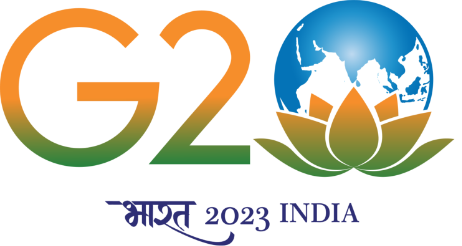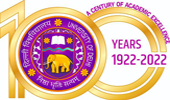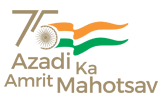NAAC – SSR
(Academic Year - 2017-18, 2018-19, 2019-20, 2020-21, 2021-22)
Criterion No. | Title | Document. |
Criterion 1 – Curricular Aspects | ||
1.1.1 | The Institution ensures effective curriculum planning and delivery through a well-planned and documented process including Academic calendar and conduct of continuous internal Assessment | |
Key Indicator- 1.2 Academic Flexibility | ||
1.2.1 | Number of Certificate/Value added courses offered and online courses of MOOCs, SWAYAM, NPTEL etc. (where the students of the institution have enrolled and successfully completed during the last five years) | |
1.2.2 | Percentage of students enrolled in Certificate/ Value added courses and also completed online courses of MOOCs, SWAYAM, NPTEL etc. as against the total number of students during the last five years | |
Key Indicator- 1.3 Curriculum Enrichment | ||
1.3.1 | Institution integrates crosscutting issues relevant to Professional Ethics, Gender, Human Values, Environment and Sustainability in transacting the Curriculum | |
1.3.2 | Percentage of students undertaking project work/field work/ internships (Data for the latest completed academic year) | |
Key Indicator- 1.4 Feedback System | ||
1.4.1 | Institution obtains feedback on the academic performance and ambience of the institution from various stakeholders, such as Students, Teachers, Employers, Alumni etc. and action taken report on the feedback is made available on institutional website | |
Criteria 2- Teaching- Learning and Evaluation Key Indicator- 2.1. Student Enrolment and Profile | ||
2.1.1 | Enrolment percentage | |
2.1.2 | Percentage of seats filled against reserved categories (SC, ST, OBC etc.) as per applicable reservation policy for the first year admission during the last five years | |
Key Indicator- 2.3. Teaching- Learning Process | ||
2.3.1 | Student centric methods, such as experiential learning, participative learning and problem solving methodologies are used for enhancing learning experiences and teachers use ICT- enabled tools including online resources for effective teaching and learning process | |
Key Indicator- 2.4 Teacher Profile and Quality | ||
2.4.1 | Percentage of full-time teachers against sanctioned posts during the last five years | |
2.4.2. | Percentage of full time teachers with NET/SET/SLET/ Ph. D./D.Sc. / D.Litt. during the last five years (consider only highest degree for count) | |
Key Indicator- 2.5. Evaluation Process and Reforms | ||
2.5.1 | Mechanism of internal/ external assessment is transparent and the grievance redressal system is time- bound and efficient | |
Key Indicator- 2.6 Student Performance and Learning Outcome | ||
2.6.1 | Programme Outcomes (POs) and Course Outcomes (COs) for all Programmes offered by the institution are stated and displayed on website | |
2.6.2 | Attainment of POs and COs are evaluated | |
2.6.3 | Pass percentage of Students during last five years | |
Key Indicator- 2.7 Student Satisfaction Survey | ||
2.7.1 | Online student satisfaction survey regarding teaching learning process. | |
Criteria 3- Research, Innovations and Extension Key Indicator 3.1- Resource Mobilization for Research | ||
3.1.1 | Grants received from Government and non-governmental agencies for research projects / endowments in the institution during the last five years (INR in Lakhs) | |
3.2.1 | Institution has created an ecosystem for innovations, Indian Knowledge System (IKS),including awareness about IPR, establishment of IPR cell, Incubation centre and other initiatives for the creation and transfer of knowledge/technology and the outcomes of the same are evident | |
3.2.2 | Number of workshops/seminars/conferences including on Research Methodology, Intellectual Property Rights (IPR) and entrepreneurship conducted during the last five years | |
Key Indicator 3.3- Research Publication and Awards | ||
3.3.1 | Number of research papers published per teacher in the Journals notified on UGC care list during the last five years | |
3.3.2 | Number of books and chapters in edited volumes/books published and papers published in national/ international conference proceedings per teacher during last five years | |
Key Indicator 3.4- Extension Activities | ||
3.4.1 | Outcomes of Extension activities in the neighborhood community in terms of impact and sensitizing the students to social issues for their holistic development during the last five years. | |
3.4.2 | Awards and recognitions received for extension activities from government / government recognised bodies | |
3.4.3 | Number of extension and outreach programs conducted by the institution through organized forums including NSS/NCC with involvement of community during the last five years | |
Key Indicators 3.5 – Collaboration | ||
3.5.1. | Number of functional MoUs/linkages with institutions/ industries in India and abroad for internship, on-the-job training, project work, student / faculty exchange and collaborative research during the last five years. | |
Criterion 4 - Infrastructure and Learning Resources Key Indicator – 4.1 Physical Facilities | ||
4.1.1 | The Institution has adequate infrastructure and other facilities for, Teaching – learning, viz., classrooms, laboratories, computing equipment etc ICT – enabled facilities such as smart class, LMS etc. | |
4.1.2 | Percentage of expenditure for infrastructure development and augmentation excluding salary during the last five years | |
Key Indicator – 4.2 Library as a learning Resource | ||
4.2.1 | Library is automated with digital facilities using Integrated Library Management System (ILMS), adequate subscriptions to e-resources and journals are made. The library is optimally used by the faculty and students | |
Key Indicator- 4.3 IT Infrastructure | ||
4.3.1 | Institution frequently updates its IT facilities and provides sufficient bandwidth for internet connection Describe IT facilities including Wi-Fi with date and nature of updation, available internet bandwidth | |
4.3.2 | Student – Computer ratio | |
Key Indicator – 4.4 Maintenance of Campus Infrastructure | ||
4.4.1 | Percentage expenditure incurred on maintenance of physical facilities and academic support facilities excluding salary component, during the last five years (INR in Lakhs) | |
Criterion 5- Student Support and Progression Key Indicator- 5.1 Student Support | ||
5.1.1 | Percentage of students benefited by scholarships and freeships provided by the institution, government and non-government bodies, industries, individuals, philanthropists during the last five years | |
5.1.2 | Capacity development and skills enhancement activities are organised for improving students’ capability | |
5.1.3 | Percentage of students benefitted by guidance for competitive examinations and career counseling offered by the Institution during the last five years | |
5.1.4 | The Institution has a transparent mechanism for timely redressal of student grievances including sexual harassment and ragging cases | |
5.2.1 | Percentage of placement of outgoing students and students progressing to higher education during the last five years | |
5.2.2 | Percentage of students qualifying in state/national/ international level examinations during the last five years | |
Key Indicator- 5.3 Student Participation and Activities | ||
5.3.1 | Number of awards/medals for outstanding performance in sports/ cultural activities at University / state/ national / international level (award for a team event should be counted as one) during the last five years | |
5.3.2 | Average number of sports and cultural programs in which students of the Institution participated during last five years (organised by the institution/other institutions) | |
Key Indicator- 5.4 Alumni Engagement | ||
5.4.1 | There is a registered Alumni Association that contributes significantly to the development of the institution through financial and/or other support services | |
Criterion 6- Governance, Leadership and Management Key Indicator- 6.1 Institutional Vision and Leadership | ||
6.1.1 | The institutional governance and leadership are in accordance with the vision and mission of the Institution and it is visible in various institutional practices such as NEP implementation, sustained institutional growth, decentralization, participation in the institutional governance and in their short term and long term Institutional Perspective Plan. | |
6.2.1 | The institutional perspective plan is effectively deployed and functioning of the institutional bodies is effective and efficient as visible from policies, administrative setup, appointment, service rules, and procedures, etc | |
6.2.2 | Implementation of e-governance in areas of operation | |
Key Indicator- 6.3 Faculty Empowerment Strategies | ||
6.3.1 | The institution has performance appraisal system, effective welfare measures for teaching and non-teaching staff and avenues for career development/progression | |
6.3.2 | Percentage of teachers provided with financial support to attend conferences/workshops and towards membership fee of professional bodies during the last five years | |
6.3.3 | Percentage of teaching and non-teaching staff participating in Faculty development Programmes (FDP), Management Development Programmes (MDPs) professional development /administrative training programs during the last five years | |
Key Indicator- 6.4 Financial Management and Resource Mobilization | ||
6.4.1 | Institution has strategies for mobilization and optimal utilization of resources and funds from various sources (government/ nongovernment organizations) and it conducts financial audits regularly (internal and external) | |
Key Indicator- 6.5 Internal Quality Assurance System | ||
6.5.1 | Internal Quality Assurance Cell (IQAC) has contributed significantly for institutionalizing the quality assurance strategies and processes. It reviews teaching learning process, structures & methodologies of operations and learning outcomes at periodic intervals and records the incremental improvement in various activities | |
6.5.2 | Quality assurance initiatives of the institution | |
Criterion 7-Institutional Values and Best Practices Key Indicator - 7.1 Institutional Values and Social Responsibilities | ||
7.1.1 | Institution has initiated the Gender Audit and measures for the promotion of gender equity during the last five years. Describe the gender equity & sensitization in curricular and co-curricular activities, facilities for women on campus etc., | |
7.1.2 | The Institution has facilities and initiatives for 1. Alternate sources of energy and energy conservation measures | |
7.1.3 | Quality audits on environment and energy regularly undertaken by the Institution. The institutional environment and energy initiatives are confirmed through the following 1. Green audit / Environment audit | |
7.1.4 | Inclusion, Situatedness, Human values & professional ethics. Describe the Institutional efforts/initiatives in providing an inclusive environment i.e., tolerance and harmony towards cultural, regional, linguistic, communal socioeconomic diversity and Sensitization of students and employees to the constitutional obligations: values, rights, duties and responsibilities of citizens | |
Key Indicator - 7.2 Best Practices | ||
7.2.1 | Two best practices successfully implemented by the Institution as per NAAC format provided in the Manual | |
7.3.1 | Portray the performance of the institution in one area distinctive to its priority and thrust | |





